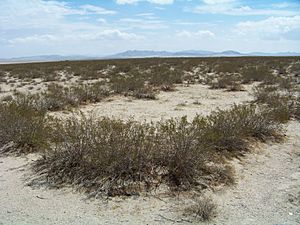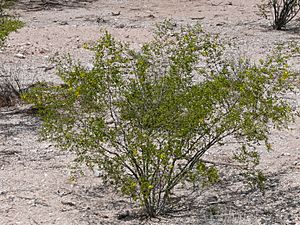Creosote bush facts for kids
Quick facts for kids Creosote bush |
|
|---|---|
 |
|
| A creosote bush in Death Valley, California | |
| Scientific classification | |
| Genus: |
Larrea
|
| Species: |
tridentata
|
The creosote bush, scientifically known as Larrea tridentata, is a very tough desert plant. It gets its common name because it smells a bit like creosote, especially after it rains. People also call it greasewood or chaparral when it's used as a traditional medicine. In Mexico, it's known as gobernadora, which means "governess." This name comes from its amazing ability to get water, which stops other plants from growing too close. Its scientific name, tridentata, refers to its leaves, which look like they have three small teeth. This plant is a type of flowering plant in the Zygophyllaceae family.
Contents
Where Creosote Bushes Grow
The creosote bush is a very common plant in the Mojave, Sonoran, and Chihuahuan Deserts of North America. You can find it in parts of California, Arizona, Nevada, Utah, New Mexico, and Texas in the United States. It also grows in many states in Mexico, including Chihuahua, Sonora, and Coahuila. It can be found as far east as Zapata County, Texas, near the Rio Grande.
What Creosote Bushes Look Like
The creosote bush is an evergreen shrub, meaning it keeps its leaves all year round. It usually grows about 1 to 3 meters (3 to 10 feet) tall, but sometimes it can reach 4 meters (13 feet). Its stems have dark green, sticky leaves. Each leaf has two small parts joined at the base, and they are about 7 to 18 millimeters (about 1/4 to 3/4 inch) long.
The flowers are yellow and have five petals, growing up to 25 millimeters (about 1 inch) wide. Sometimes, small bumps called galls can form on the plant. These are caused by tiny insects called creosote gall midges. The whole plant has that special creosote smell, which many people connect with the "smell of rain" in the desert.
Animals That Use Creosote Bushes
Many desert animals interact with the creosote bush:
- Leaves: Only jackrabbits eat the leaves, and usually only when they can't find anything else, because the leaves are bitter. Desert iguanas and chuckwallas also eat the leaves.
- Seeds: Desert woodrats and kangaroo rats enjoy eating the seeds.
- Flowers: About 22 different kinds of bees visit the flowers to collect pollen, helping the plant make new seeds. Chuckwallas and desert iguanas also eat the flowers.
- Many types of insects also live on or around the creosote bush.
Interestingly, when Arabian camels were brought to the American deserts long ago, they readily ate the creosote bush. Scientists think this might have reconnected a relationship that was lost when ancient American camels died out thousands of years ago.
The Oldest Creosote Bushes
As a creosote bush gets very old, its oldest branches can die. The plant's main crown then splits into separate parts. This usually happens when the plant is between 30 and 90 years old. Over time, the original plant might die, but new plants grow from its roots, forming a "clonal colony." This means all the new plants are genetically identical to the original one, like many copies of the same plant.
King Clone: An Ancient Plant
One famous creosote bush colony, called "King Clone," is one of the oldest living organisms on Earth. It's estimated to be about 11,700 years old! This amazing plant lives in the central Mojave Desert in California. This single colony forms a large ring that can be up to 67 feet (20 meters) across, with an average size of 45 feet (14 meters).
A professor named Frank Vasek from the University of California, Riverside discovered King Clone and figured out its age. He measured how fast the plant grew outwards from its center and used radiocarbon dating on old wood pieces. By knowing its growth rate and the size of the ring, he could estimate how old it was. King Clone is now protected in the Creosote Rings Preserve.
Where Creosote Bushes Like to Live
Creosote bushes grow best on well-drained soils, like those found on alluvial fans (fan-shaped deposits of sediment at the base of mountains) and flat areas. In some places, they can cover huge areas almost by themselves. However, they often grow alongside another plant called Ambrosia dumosa, or burro bush.
You might notice that creosote bushes tend to be spread out quite evenly from each other. For a long time, people thought the plants released a chemical that stopped other bushes from growing too close. But now, we know that the roots of mature creosote plants are just incredibly good at soaking up water. This means that any seeds that fall nearby can't get enough water to sprout, creating empty spaces around each plant.
How Creosote Bushes Survive the Desert
Young creosote bushes have a much harder time surviving droughts than older, established plants. Many young plants sprout during wet periods, but most of them die quickly if there isn't enough water. The hot desert ground, which can reach over 70°C (160°F), makes it even harder for young plants. For a young creosote bush to survive and grow strong, it usually needs three to five years of unusually cool and wet weather after it sprouts. This suggests that all the plants in a single group or stand might be about the same age.
However, mature creosote bushes are incredibly tough and can handle extreme drought. They can still function even when water is very scarce. When it finally rains, these plants can quickly absorb water, causing their branches to grow several centimeters in a short time.
The creosote bush also has special ways to save water. Its small leaves have a waxy, sticky coating that helps reduce water loss. Their small size also prevents them from getting too hot, which would make them lose more water. During hot summers, the plants might drop some leaves, but if they lose all their leaves, they usually can't recover. The fallen leaves and other bits of plant material that collect under the bush create a unique little home for other creatures, like beetles, millipedes, pocket mice, and kangaroo rats.
Images for kids
See also
 In Spanish: Larrea tridentata para niños
In Spanish: Larrea tridentata para niños







